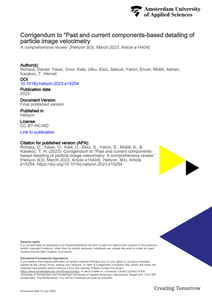Corrigendum to original article: Elwin R. Savelsbergh, Gjalt T. Prins, Charlotte Rietbergen, Sabine Fechner, Bram E. Vaessen, Jael M. Draijer, Arthur Bakker Effects of innovative science and mathematics teaching on student attitudes and achievement: A meta-analytic study Educational Research Review, Volume 19, November 2016, Pages 158-172 https://doi.org/10.1016/j.edurev.2016.07.003
LINK
In the Abstract the following is sentence is changed:Original abstract sentenceA strong negative correlation was found between theTSK-NL Heart and the HADS (Anxiety) (rs –0.51).Corrected abstract sentenceStrong positive correlations were found between theTSK-NL Heart and de HADS (Anxiety) (rs: 0.60) andbetween the TSK-NL Heart and the CAQ (rs: 0.61).
DOCUMENT

The authors regret that during a recent review of this work, an erroneous calculation was uncovered. In our discussion we estimated the number of VAD patients annually with recent manipulation in the U.S. If the annual rate of VAD patients in the U.S. population was approximately (318,857,056 × 1.0/100.000) 3188, and of those patients 6.9% received a cervical manipulation, the correct number should be (3188 × 0.069) 220. This had been accidentally calculated as 220,011 instead of 220. Although it does not change the overall conclusions or discussion of the paper, the authors would like to thank dr. Clum for his attentiveness and apologize for any inconvenience caused.
DOCUMENT
SummaryBackground & aimsQualitative studies suggest that malnutrition awareness is poor in older adults. The aim of this study was to develop a questionnaire to quantitatively assess malnutrition awareness in community-dwelling older adults aged 60+ years.MethodsThe Malnutrition Awareness Scale (MAS) was developed based on the awareness phase of the Integrated-Change model, and included four domains: knowledge, perceived cues, risk perceptions, and cognizance. Twenty-six scale items were developed using results from mainly qualitative research and the expertise of the authors. Items were piloted in 10 Dutch older adults using the Thinking Aloud method to optimize wording. In a feasibility study, annoyance, difficulty and time to complete the MAS and its comprehensibility were tested. After final revisions, the MAS was applied to a large sample to test its psychometric properties (i.e., inter-item correlations, Cronbach's alpha, score distribution) and relevance of the items was rated on a 5-point scale by 12 experts to determine content validity.ResultsThe feasibility study (n = 42, 55 % women, 19 % 80+ y) showed that the MAS took 12 ± 6 min to complete. Most participants found it not (at all) annoying (81 %) and not (at all) difficult (79 %) to complete the MAS, and found it (very) comprehensible (83 %). Psychometric analyses (n = 216, 63 % women, 28 % 80+ y) showed no redundant items, but two items correlated negatively with other items, and one correlated very low. After removal, the final MAS consists of 23 items with a min–max scoring range from 0 to 22 (with higher scores indicating higher awareness) and an overall Cronbach's alpha of 0.67. The mean MAS score in our sample (n = 216) was 14.8 ± 3.2. The lowest obtained score was 6 (n = 3) and the highest 22 (n = 1), indicating no floor or ceiling effects. Based on the relevance rating, the overall median across all 22 items was 4.0 with IQR 4.0–5.0.ConclusionThe Malnutrition Awareness Scale is a novel, feasible and reliable tool with good content validity to quantitively assess malnutrition awareness in community-dwelling older adults. The scale is now ready to identify groups with poor malnutrition awareness, as a basis to start interventions to increase malnutrition knowledge and awareness.
DOCUMENT
In the original published version of this article, the affiliations for the authors were listed incorrectly. This has now been corrected. The corrected affiliations for the authors can be found below. The authors apologize for the errors. Both the HTML and PDF versions of the article have been updated to correct the errors.
DOCUMENT

DOCUMENT
![Corrigendum to "Effects of physical therapy for temporomandibular disorders on headache pain intensity: a systematic review" [Musculoskeletal science and practice 50 (2020) 102277]](https://publinova-harvester-content-prod.s3.amazonaws.com/thumbnails/files/previews/pdf/20250619195522480225.20250619175008103960.1_s2.0_S246878122100028X_main-thumbnail-400x300.png)
Conducting large calculations manually with pen and paper following prescribed procedures or algorithms has been diminishing in significance for some time. In most cultures, and for many years already, individuals employ digital instruments for such computational tasks, when confronted with them in daily life. Yet, a closer examination of prevalent practices in the teaching of basic numeracy skills in adult education reveals a persistent emphasis on mastering standardized manual calculation techniques, especially with abstract and decontextualized numbers. This emphasis predominantly stems from the belief that mastering these manual procedures forms the cornerstone of all numeracy abilities. Contrastingly, our research indicates that the numeracy skills most frequently utilized and required in contemporary professions and daily activities encompass higher-order capabilities (Hoogland and Stoker, 2021; Boels et al., 2022; Hoogland and Díez-Palomar, 2022). These include interpretation, reasoning, mathematizing, estimation, critical reflection on quantitative data, and the application of digital instruments for computation. It is imperative, therefore, that numeracy education for adults prioritizes these competencies to achieve efficacy.
LINK
DOCUMENT

Purpose: This is a position paper describing the elements of an international framework for assistive techhnology provision that could guide the development of policies, systems and service delivery procedures across the world. It describes general requirements, quality criteria and possible approaches that may help to enhance the accessibility of affordable and high quality assistive technology solutions. Materials and methods: The paper is based on the experience of the authors, an analysis of the existing literature and the inputs from many colleagues in the field of assistive technology provision. It includes the results of discussions of an earlier version of the paper during an international conference on the topic in August 2017. Results and conclusion: The paper ends with the recommendation to develop an international standard for assistive technology provision. Such a standard can have a major impact on the accessibility of AT for people with disabilities. The paper outlines some the key elements to be included in a standard.
DOCUMENT

DOCUMENT
